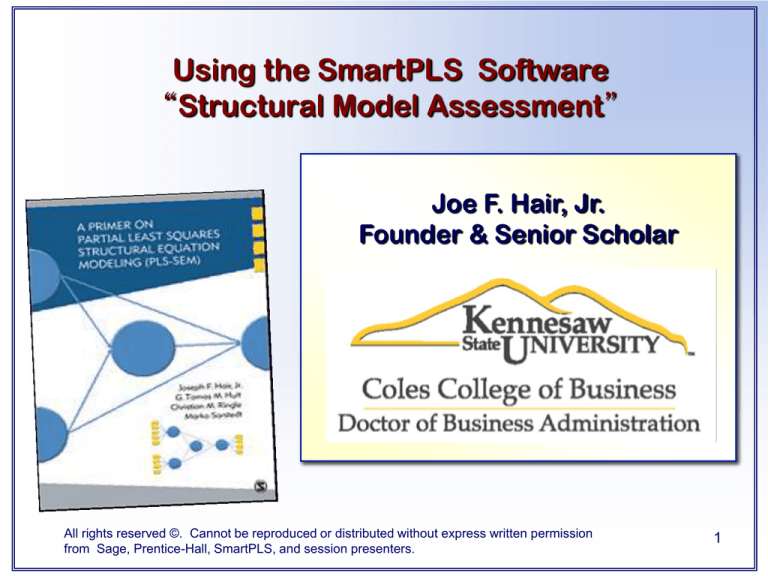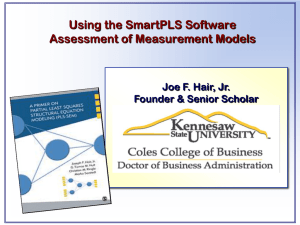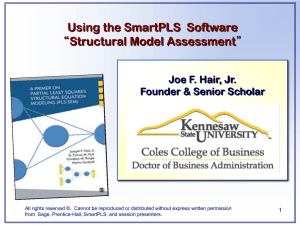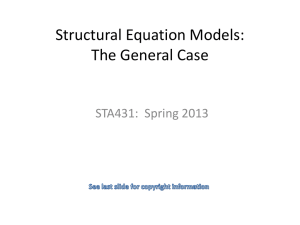
Using the SmartPLS Software
“Structural Model Assessment”
Joe F. Hair, Jr.
Founder & Senior Scholar
All rights reserved ©. Cannot be reproduced or distributed without express written permission
from Sage, Prentice-Hall, SmartPLS, and session presenters.
1
Step 3: Assess the Level of R2
The R² values of the endogenous latent variables are available in the
PLS Algorithm default report (PLS → Quality Criteria → Overview), as
shown below. The R2 values of COMP (0.6309), CUSL (0.5620), and
LIKE (0.5576) can be considered moderate. In contrast, the R² value of
CUSA (0.2919) is rather weak.
All rights reserved ©. Cannot be reproduced or distributed without express written permission
from Sage, Prentice-Hall, SmartPLS, and session presenters.
2
2
Note: calculation of Q2 value is shown in a later slide.
3
Step 4: Assessing Effect Size – ƒ 2
The ƒ² effect size is a measure of the impact of a specific
predictor construct on an endogenous construct. In addition to
evaluating the size of the R² values of all endogenous constructs, the
ƒ² effect size can be calculated (it is not available from the SmartPLS
software output). The ƒ² effect size measures the change in the R²
value when a specified exogenous construct is omitted from the model.
It is used to evaluate whether the omitted predictor construct has a
substantive impact on the R² values of the endogenous construct(s).
The formula for calculating the ƒ² effect size is shown on the next
slide. Guidelines for assessing ƒ2 values for the exogenous latent
constructs in predicting the endogenous constructs are:
Value
0.02
0.15
0.35
=
=
=
Effect Size
small
medium
large
(Cohen, 1988)
All rights reserved ©. Cannot be reproduced or distributed without express written permission
from Sage, Prentice-Hall, SmartPLS, and session presenters.
4
Calculating the Effect Size – ƒ 2
The f 2 effect size can be calculated as shown below. In the formula
R2included and R2excluded are the R² values of the endogenous latent
variable when a selected exogenous latent variable is included or
excluded from the model. The change in the R² values is calculated by
estimating the PLS path model twice. It is estimated the first time
with the exogenous latent variable included (yielding R2included) and
the second time with the exogenous latent variable excluded (yielding
R2excluded).
The results of calculating the f 2 for the reputation model example
endogenous variables are shown in a later slide.
All rights reserved ©. Cannot be reproduced or distributed without express written permission
from Sage, Prentice-Hall, SmartPLS, and session presenters.
5
Example: Calculation of f2 Effect Size
As indicated in the previous slide, to compute the f2 value of a
selected endogenous latent construct, we need the R2 included
and R2excluded values. The R2included results from the overall
model estimation were previously shown (Exhibit 6.15). The
R2excluded value is obtained from a model re-estimation after
deleting a specific predecessor of that endogenous latent
variable. For example, the endogenous latent variable CUSL
has an original R2 value of 0.562 (R2included). If CUSA is
deleted from the path model and the model is re-estimated, the
R2 of CUSL has a value of only 0.385 (R2excluded). These two
values are the inputs for computing the f2 effect size of CUSA on
CUSL. The formula is shown below:
6
Example: Calculation of f2 for other endogenous constructs
To get the f2 values you need to run the full model first and
determine the R2 for the endogenous construct you want to
evaluate. Next, eliminate one path pointing at the construct
you are looking at (simply right click on a construct and delete
the predictor construct), and re-run the model. The R2 with the
construct/path will be lower since the predictor construct was
removed. Now enter the R2 included for the selected
construct (based on the full model) and the R2 excluded
(based on the reduced model where one path/construct has
been deleted) into the formula on the previous slide.
The same procedure is followed for the q2 but instead of
entering the R2 (excluded and included), you use blindfolding
to get the Q2 values for the full model (included) and the
reduced model (construct/path deleted).
All rights reserved ©. Cannot be reproduced or distributed without express written permission from
Prentice-Hall, McGraw-Hill, SmartPLS, and session presenters.
7
Summary of Results – Path Coefficients, f2 and q2
COMP
CUSL
Path
Coefficient
f2 effect
size
q2 effect
size
0.0057
0.000
0.101
CUSA
0.5050
0.404
0.229
LIKE
0.3440
0.139
0.081
ATTR
Path
Coefficient
f2 effect
size
q2 effect
size
0.0861
0.011
0.028
COMP
CSOR
0.0589
0.005
0.004
PERF
0.2955
0.076
0.042
QUAL
0.4297
0.144
0.062
Example interpretation of f2: Look under the f2 column for CUSL. Note
the 0.404 is the f2 effect size for the predictive value of CUSA on CUSL. The
0.404 indicates that CUSA has a large effect in producing the R2 for CUSL. In
contrast, the 0.139 is the f2 effect size for the predictive value of LIKE on
CUSL. The 0.139 indicates that LIKE has close to a medium effect in
8
producing the R2 for CUSL.
Reputation Model Results
– Path Coefficients –
Guidelines for assessing
ƒ2 values:
Value
Effect Size
0.02
=
small
0.15
=
medium
All rights reserved ©. Cannot be reproduced or distributed without express written permission
9
0.35
=
large
from Sage, Prentice-Hall, SmartPLS, and session presenters.
Summary of Results – Path Coefficients, f2 and q2
CUSA
Path
Coefficient
f2 effect
size
q2 effect
size
0.1671
0.029
0.019
0.1784
0.036
0.029
PERF
0.1170
0.011
0.007
QUAL
0.3800
0.095
0.053
Path
Coefficient
f2 effect
size
LIKE
q2 effect
size
ATTR
COMP
0.1455
0.018
0.001
CSOR
CUSA
LIKE
0.4357
0.161
0.140
10
Step 5: Blindfolding and Predictive Relevance – Q 2
In addition to evaluating the magnitude of the R² values as a criterion of
predictive accuracy, researchers should also examine the Q² value – which
is an indicator of the model’s predictive relevance. The Q² measure
applies a sample re-use technique that omits part of the data matrix and
uses the model estimates to predict the omitted part. Specifically, when a
PLS-SEM model exhibits predictive relevance, it accurately predicts the data
points of the indicators in reflective measurement models of multi-item as
well as single-item endogenous constructs (the procedure does not apply to
formative endogenous constructs).
For SEM models, Q² values larger than zero for a specific reflective
endogenous latent variable indicate the path model’s predictive relevance
for a particular construct. Q² values of zero or below indicate a lack of
predictive relevance. As a relative measure of predictive relevance, values
of 0.02, 0.15, and 0.35 indicate that an exogenous construct has a small,
medium, or large predictive relevance for a selected endogenous construct.
All rights reserved ©. Cannot be reproduced or distributed without express written permission
from Sage, Prentice-Hall, SmartPLS, and session presenters.
11
Blindfolding and Predictive Relevance – Q 2
The Q ² value can be calculated by using two different approaches.
The cross-validated redundancy approach uses the path model
estimates of both the structural model (scores of the antecedent
constructs) and the measurement model (target endogenous constructs).
An alternative method is the cross-validated communality
approach. This method uses only the construct scores estimated for the
target endogenous construct (without including the structural model
information) to predict the omitted data points.
We recommend using the cross-validated redundancy as a measure
of Q2 since it includes the key element of the path model, the structural
model, to predict eliminated data points.
When you run the blindfolding option for cross-validated redundancy,
all constructs in your SEM model are shown (see next slide). You can
select multiple latent variables in the dialog box, but you need to run this
routine for one reflective target construct at a time – one after the other
until all have been tested. Finally, this option is only used with
endogenous constructs that are measured reflectively.
All rights reserved ©. Cannot be reproduced or distributed without express written permission
from Sage, Prentice-Hall, SmartPLS, and session presenters.
12
SmartPLS Predictive Relevance – Blindfolding
Redundancy vs. Communality?
Cross-validated redundancy
Step 1:
The scores of the endogenous LV(s)
are estimated using the scores of the
exogenous LVs
LV1
MV 1
LV3
MV 3
LV2
LV1
Step 2:
Newly estimated LV scores are used
to estimate the missing MV data
MV 1
LV3
MV 2
MV 3
LV2
Cross-validated communality
MV 2
Only step 2.
.
Running Blindfolding to obtain Q2
for Endogenous Construct CUSL
Note that only CUSL is checked.
All rights reserved ©. Cannot be reproduced or distributed without express written permission
from Sage, Prentice-Hall, SmartPLS, and session presenters.
14
Blindfolding Results for Endogenous Construct CUSL
.
Q2 value for CUSL
Full Base Model
The result column is at the top right
corner (1 – SSE/SSO). For our path
model the predictive relevance Q2 of
CUSL has a value of 0.4178, which
indicates the model has large predictive
relevance for this construct.
When blindfolding is run for all
endogenous latent constructs in the model
they all have Q2 values considerably
All rights reserved ©. Cannot be reproduced or distributed without express written permission
above
as shownSmartPLS,
on theand
next
slide.
from zero,
Sage, Prentice-Hall,
session
presenters.
15
Reputation Model – R2 and Q2 Measures
The table above shows that all Q2 values are considerably above zero, thus
providing support for the reputation model’s predictive relevance for the four
endogenous constructs.
Computation of q 2
The final assessment addresses the calculation of the q² effect
sizes. The calculation of q2 for the CUSL construct of the reputation
model is shown below. To compute the q² value of a selected
endogenous latent variable, you need the Q2included and Q2excluded
values. The Q2included results for all endogenous constructs from the
overall model estimation are available from a previous slide. The
Q2excluded value is obtained from a model re-estimation after deleting a
specific predecessor of that endogenous latent variable. For example,
the endogenous latent variable CUSL has an original Q² value of 0.418
(Q2included). If CUSA is deleted from the path model and the model is
re-estimated, the Q² of CUSL has a value of only 0.285 (Q2excluded ).
These two values are the inputs for computing the q² effect size of
CUSA. on CUSL, as shown below:
All rights reserved ©. Cannot be reproduced or distributed without express written permission
from Sage, Prentice-Hall, SmartPLS, and session presenters.
17
PLS Algorithm Results
Base Model with CUSA Removed
.
All rights reserved ©. Cannot be reproduced or distributed without express written permission
from Sage, Prentice-Hall, SmartPLS, and session presenters.
18
Blindfolding Results for
CUSL with full Base Model
.
Q2 value for CUSL
with full model
All rights reserved ©. Cannot be reproduced or distributed without express written permission
from Sage, Prentice-Hall, SmartPLS, and session presenters.
19
Blindfolding Results for CUSL
Reduced Model with CUSA Removed
Q2 value for CUSL
with CUSA Removed
.
All rights reserved ©. Cannot be reproduced or distributed without express written permission
from Sage, Prentice-Hall, SmartPLS, and session presenters.
20
Summary of Results – Path Coefficients, f2 and q2
COMP
CUSL
Path
Coefficient
f2 effect
size
q2 effect
size
0.0057
0.000
0.101
CUSA
0.5050
0.404
0.229
LIKE
0.3440
0.139
0.081
ATTR
Path
Coefficient
f2 effect
size
q2 effect
size
0.0861
0.011
0.028
COMP
CSOR
0.0589
0.005
0.004
PERF
0.2955
0.076
0.042
QUAL
0.4297
0.144
0.062
Example interpretation of q2: Look under the q2 column for CUSL. Note
the 0.229 is the q2 effect size for the predictive relevance of CUSA on CUSL.
The 0.229 indicates that CUSA has a medium effect in producing the Q2
(predictive relevance) for CUSL. In contrast, the 0.081 is the q2 effect size for
the predictive relevance of LIKE on CUSL. The 0.081 indicates that LIKE has a
21
small effect in producing the Q2 for CUSL.
Reputation Model Results
– Path Coefficients –
Guidelines for assessing
q2 values:
Value
Effect Size
0.02
=
small
0.15
=
medium
All rights reserved ©. Cannot be reproduced or distributed without express written permission
22
0.35
=
large
from Sage, Prentice-Hall, SmartPLS, and session presenters.
Summary of Results – Path Coefficients, f2 and q2
CUSA
Path
Coefficient
f2 effect
size
LIKE
q2 effect
size
ATTR
COMP
0.1455
0.018
Path
Coefficient
f2 effect
size
q2 effect
size
0.1671
0.029
0.019
0.1784
0.036
0.029
0.1170
0.011
0.007
0.3800
0.095
0.053
0.001
CSOR
CUSA
LIKE
PERF
QUAL
0.4357
0.161
0.140
Guidelines for assessing
q2 values associated with
predictive relevance (Q2):
Value
Effect Size
0.02
=
small
0.15
=
medium
0.35
=
large
23
.
.
All rights reserved ©. Cannot be reproduced or distributed without express written permission
from Sage, Prentice-Hall, SmartPLS, and session presenters.
25








